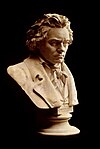Related Research Articles

Fidelio, originally titled Leonore, oder Der Triumph der ehelichen Liebe, Op. 72, is the only opera by German composer Ludwig van Beethoven. The libretto was originally prepared by Joseph Sonnleithner from the French of Jean-Nicolas Bouilly. The opera premiered at Vienna's Theater an der Wien on 20 November 1805. The following year, Beethoven's friend Stephan von Breuning rewrote the libretto, shortening the work from three acts to two. After further work on the libretto by Georg Friedrich Treitschke, a final version was performed at the Kärntnertortheater on 23 May 1814. As these libretto revisions were going on, Beethoven was also revising some of the music. By convention, only the final version is called Fidelio, and the others are referred to as Leonore.
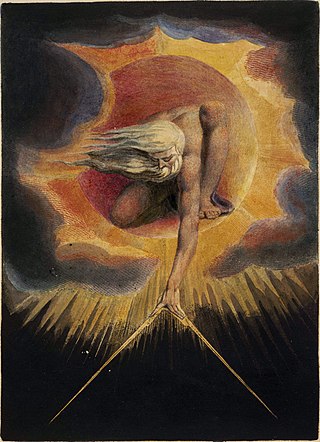
The Creation is an oratorio written in 1797 and 1798 by Joseph Haydn, and considered by many to be one of his masterpieces. The oratorio depicts and celebrates the creation of the world as narrated in the Book of Genesis.

"Gott erhalte Franz den Kaiser" was a personal anthem to Francis II, Emperor of the Holy Roman Empire and later of the Austrian Empire, with lyrics by Lorenz Leopold Haschka (1749–1827) and music by Joseph Haydn. It is sometimes called the "Kaiserhymne". Haydn's tune has since been widely employed in other contexts: in works of classical music, in Christian hymns, in alma maters, and as the tune of the "Deutschlandlied", the national anthem of Germany.

The Piano Concerto No. 5 in E-flat major, Op. 73, known as the Emperor Concerto in English-speaking countries, is a piano concerto composed by Ludwig van Beethoven. Beethoven composed the concerto in 1809 under salary in Vienna, and he dedicated it to Archduke Rudolf, who was his patron, friend, and pupil. Its public premiere was on 28 November 1811 in Leipzig, with Friedrich Schneider as the soloist and Johann Philipp Christian Schulz conducting the Gewandhaus Orchestra. Beethoven, usually the soloist, could not perform due to declining hearing.
Christus am Ölberge, Op. 85, is an oratorio by Ludwig van Beethoven portraying the emotional turmoil of Jesus in the garden of Gethsemane prior to his crucifixion. It was begun in the fall of 1802, soon after his completion of the Heiligenstadt Testament, as indicated by evidence in the Wielhorsky sketchbook. The libretto in German is by the poet Franz Xaver Huber, editor of the Wiener Zeitung, with whom Beethoven worked closely. It was written in a very short period; in a letter to Breitkopf & Härtel written shortly after the oratorio's completion, Beethoven spoke of having written it in "a few weeks", although he later claimed that the piece required no more than 14 days to complete. It was first performed on April 5, 1803 at the Theater an der Wien in Vienna; in 1811, it was revised by Beethoven for publication by Breitkopf & Härtel. The 10 years that passed between the composition of the work and its publication resulted in its being assigned a relatively high opus number. The piece premiered in the United States in 1809; it was Beethoven's first success in the United States.
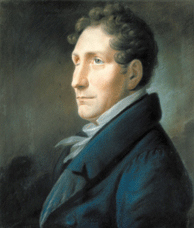
Friedrich Daniel Rudolf Kuhlau was a Danish pianist and composer during the late Classical and early Romantic periods. He was a central figure of the Danish Golden Age and is immortalized in Danish cultural history through his music for Elves' Hill, the first true work of Danish National Romanticism and a concealed tribute to the absolute monarchy. To this day it is his version of this melody which is the definitive arrangement.

The Fantasy for piano, vocal soloists, mixed chorus, and orchestra, Op. 80, usually called the Choral Fantasy, was composed in 1808 by then 38-year-old Ludwig van Beethoven.

In music, an octet is a musical ensemble consisting of eight instruments or voices, or a musical composition written for such an ensemble.
The Ruins of Athens, Op. 113, is a set of incidental music pieces written in 1811 by Ludwig van Beethoven. The music was written to accompany the play of the same name by August von Kotzebue, for the dedication of the new Deutsches Theater Pest in Pest, Hungary.
Zur Namensfeier, Op. 115, is a symphonic overture in C major by Ludwig van Beethoven, completed in 1815 and first performed on Christmas Day 1815. It is dedicated to Polish prince Antoni Radziwiłł, who is remembered for his patronage of the arts who supported others like Paganini, Goethe and Chopin. The piece was never one of Beethoven's more popular works and is seldom played today.
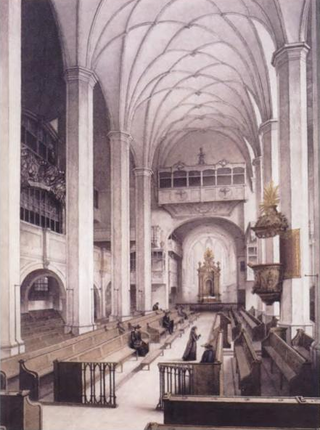
Johann Sebastian Bach composed the church cantata Es ist nichts Gesundes an meinem Leibe, BWV 25 in Leipzig for the 14th Sunday after Trinity and first performed it on 29 August 1723.
Ferdinand Ries composed the Symphony No. 5 in D minor, Op. 112, in London in 1813. It was the second symphony Ries wrote. It was first performed at a Philharmonic Society concert on 14 February 1814. In 1823, Breitkopf & Härtel published the work together with piano solo, piano duet and chamber arrangements.
Meeresstille und Glückliche Fahrt, Op. 112 is a cantata for chorus and orchestra composed by Ludwig van Beethoven. It is based on a pair of poems by Johann Wolfgang von Goethe. They met in 1812; Beethoven admired him and the work is dedicated to Goethe. It was first performed in Vienna on 25 December 1815, and first published in 1822. The piece is in a single movement, with a typical performance taking between 7 and 8 minutes. The single movement is in two sections: (1) "Meeresstille" – Sostenuto – D major; and (2) "Glückliche Fahrt" – Allegro vivace – D major.
"Germania", WoO 94, is a patriotic song by Ludwig van Beethoven written in order to celebrate the victory against Napoleon.
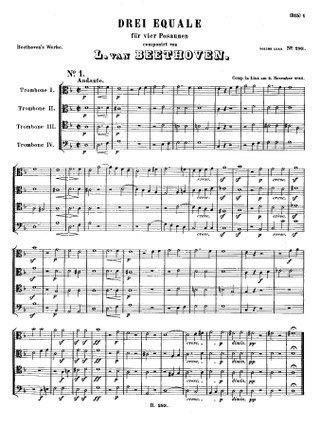
The Three Equals for four trombones, WoO 30, are three short equales for trombones by Ludwig van Beethoven.
Der glorreiche Augenblick, Op. 136 is a cantata by Ludwig van Beethoven.
Es ist vollbracht is a German expression. It may refer to:
References
- ↑ Thayer, Alexander Wheelock; Deiters, Hermann; Riemann, Hugo (2013-09-05). The Life of Ludwig van Beethoven. Vol. 2. Cambridge University Press. p. 317. ISBN 9781108064743.
- ↑ Treitschke, Friedrich (1817). "Es ist vollbracht". Gedichte [Poems]. Wallishauser. p. 109.
- ↑ Mathew, Nicholas (2013). Political Beethoven . Cambridge University Press. p. 1. ISBN 9781107005891.
- ↑ Guanti, Giovanni (1995). Invito all'ascolto di Ludwig van Beethoven (in Italian). Mursia. p. 174. ISBN 9788842516477.
- ↑ Lee, Alexander (March 2018). "Beethoven and Napoleon". History Today. 68 (3).
